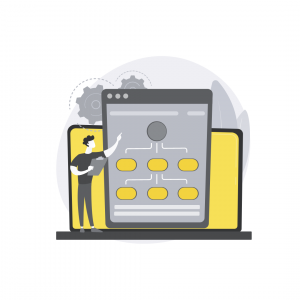What are functional requirements?
Functional requirements define what an app is expected to do. They are the essential functions without which the app would not function or perform as intended. These are requirements that must be met and cannot be skipped. These requirements must be documented before the app is built and assessed again before it is completed and the result is delivered to the user.
Why functional requirements need to be documented?
– Helps you in determining whether the application provides all the functions included in the application’s functional requirements.
– Clear requirements keep all developers, designers, and QA testers on the same page and working toward the same goal, preventing misunderstandings.
– Detailed, high-quality requirements facilitate the team’s ability to estimate development time and cost and develop a product that meets expectations more accurately.
– Thoroughly capturing functional requirements during the discovery phase aids in identifying and correcting errors early on, saving time and resources.
Functional requirements examples:
Looking at some functional requirements examples is helpful to understand what they are. Functional requirements are comprised of both product features and user requirements.
Here are some examples of well-written functional requirements:
– The system must send a confirmation email whenever an order is placed.
– The system must allow blog visitors to sign up for the newsletter by leaving their email.
– The system must allow users to verify their accounts using their phone number.
Functional requirements are not the same as user stories. However, user stories can be a useful method for generating needs with the user in mind. As an example, as an existing user, I want to be able to log into my account.
Functional requirements:
– Users must be able to access their accounts by entering their email address and password.
– Users must be able to log in using their Google accounts.
– Users must be able to reset their passwords by clicking “I forgot my password” and receiving an email with a link sent to their verified email address.
Functional requirements should be as clear as possible:
Requirements must be clear and understandable.
Make sure your requirements are written in a clear and simple manner that avoids confusion or multiple interpretations. Also, avoid using technical language. Keep in mind that each audience is unique, and investors may not be familiar with technical jargon. Instead, include images, diagrams, and graphs in your documents to help people understand the information.
Requirements must be specific, accurate, and complete.
Keep your terminology consistent and make sure your requirements are correct when developing your documentation. They should cover every scenario, but they should never contradict one another. Avoid misleading language and weak terms like “the system must be quick” or “when something happens.” Make the terms specific and measurable so that all readers may understand them.
Requirements must be testable.
Write the requirements in such a way that testing can verify whether they are delivered successfully after the product is produced.
Requirements must be feasible and sensible.
Focus on the features and qualities that users genuinely require. Keep in mind that requirements must represent higher-level company goals.
Every resource is valuable when it comes to business app development. Understanding your functional requirements can save you time, money, and human resources when developing an app. Clearly defining functional and non-functional requirements is like having a detailed road – map with pit stops marked out. This way, you’ll know exactly how much time you need.
Once you’ve determined your requirements, you can begin working on the functional requirements right away, leaving room for changes based on iterations and client feedback. When it time comes to scrape deadlines and drop a few bells and whistles, you’ll know exactly which components you want to keep.
